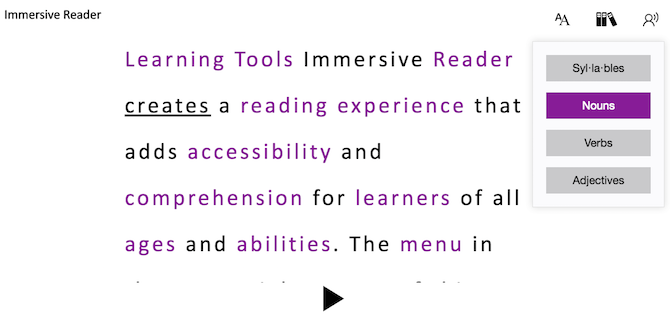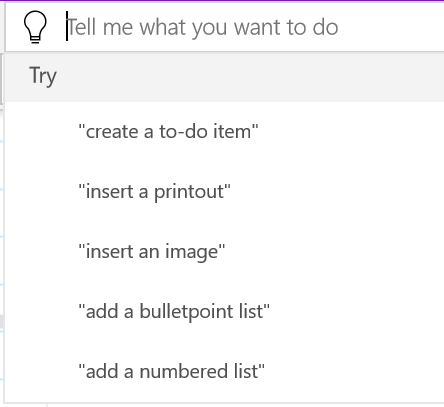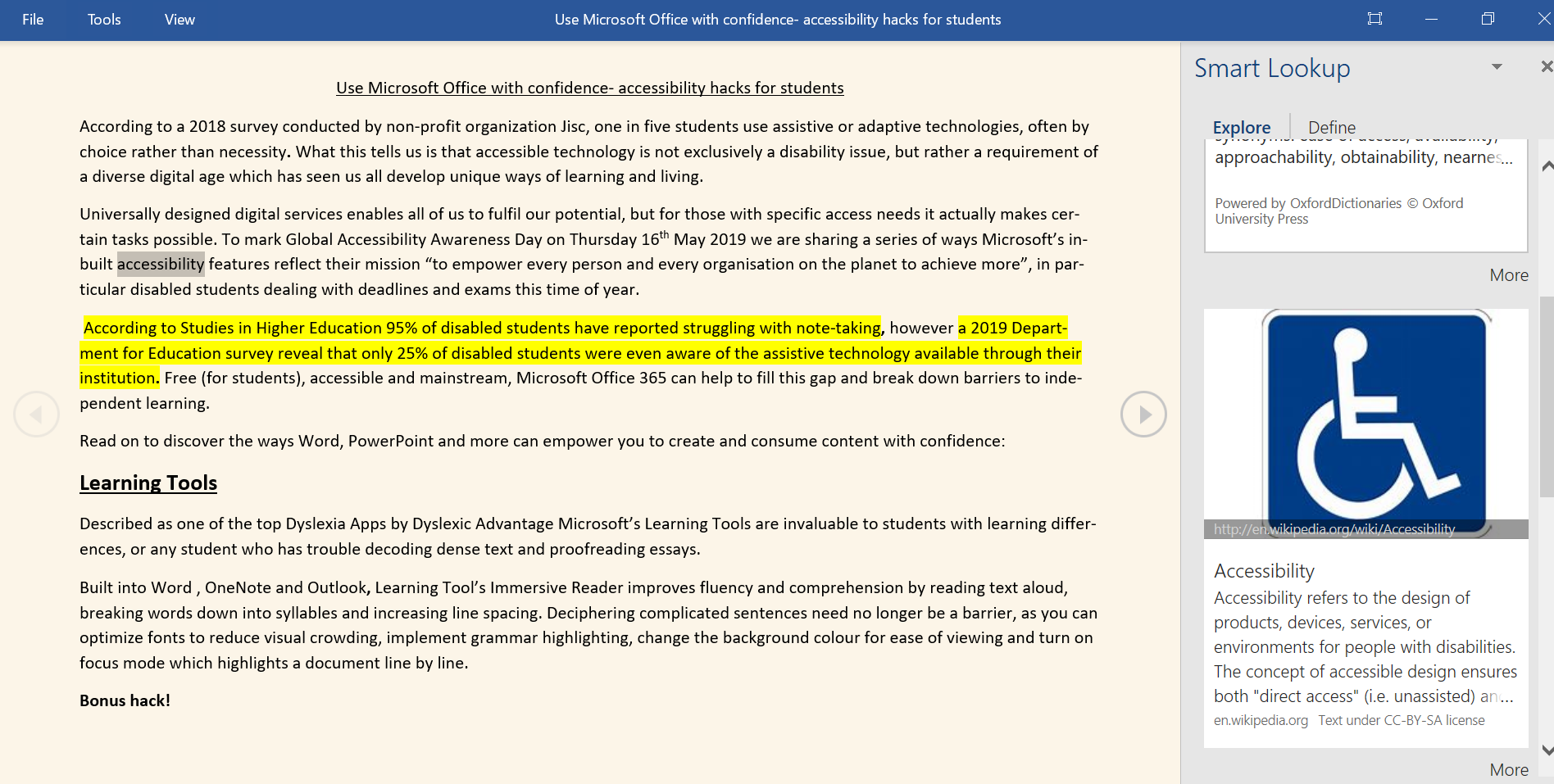Use Microsoft Office with confidence - accessibility hacks for students #GAAD
Jessica Doyle | 15 May 2019According to a 2018 survey conducted by non-profit organization Jisc, one in five students use assistive or adaptive technologies, often by choice rather than necessity. What this tells us is that accessible technology is not exclusively a disability issue, but rather a requirement of a diverse digital age which has seen us all develop unique ways of learning and living.
Universally designed digital services enable all of us to fulfill our potential, but for those with specific access needs it is essential to make certain tasks possible. To mark Global Accessibility Awareness Day on Thursday 16th May 2019 we are sharing a series of ways Microsoft’s in-built accessibility features reflect their mission “to empower every person and every organisation on the planet to achieve more”, in particular disabled students dealing with deadlines and exams this time of year.
Having trouble taking notes in lectures? You're not alone!
According to Studies in Higher Education 95% of disabled students have reported struggling with note-taking, however a 2019 Department for Education survey reveal that only 25% of disabled students were even aware of the assistive technology available through their institution.
Free (for students), accessible and mainstream, Microsoft Office 365 can help to fill this gap and break down barriers to independent learning.
Read on to discover the ways Word, PowerPoint and more can empower you to create and consume content with confidence:
Learning Tools
Described as one of the top Dyslexia Apps by Dyslexic Advantage Microsoft’s Learning Tools are invaluable to students with learning differences, or any student who has trouble decoding dense text and proofreading essays.
Built into Word, OneNote and Outlook, Learning Tool’s Immersive Reader improves fluency and comprehension by reading text aloud, breaking words down into syllables and increasing line spacing. Deciphering complicated sentences need no longer be a barrier, as you can optimize fonts to reduce visual crowding, implement grammar highlighting, change the background colour for ease of viewing and turn on focus mode which highlights a document line by line.

Bonus hack!
Lecture slide content too dense to jot down quickly? Snap a photo of it using Office Lens, the in-built camera tool for OneNote, and have the photographed text decoded for you in immersive reader!
Type with confidence
AutoCorrect and AutoText in Microsoft Word helps to make the act of typing more accessible. Having to repeat specific phrases, names or terminology in an essay can become laborious, especially if you use alternative keyboards or special input methods to type. In just a few short steps you can add stock phrases to AutoText and attach acronyms to words in AutoCorrect to help reduce the number of keys you need to press! You can visit our My Computer My Way resource for clear instructions on how to enable AutoText and AutoCorrect in Word.
Bonus Hack!
Look out for Microsoft Word’s new ‘Ideas’ feature being released in June 2019 to enhance your writing and ensure your thoughts are expressed with clarity. Moving on from Editor in word which checks spelling, grammar and basic stylistic issues, this feature uses AI technology to consider natural speaking patterns and even suggest more gender-inclusive language.
 Tell me
Tell me
Microsoft’s new Tell Me feature in all Office 365 apps enables you to access several functions without navigating the command ribbon. A lightbulb icon for those eureka moments aptly represents a text box which says, ‘tell me what you want to do’. Using everyday language, you can uncover the more complex capabilities of Microsoft and save time by simply typing out the feature you want to use or the action you want to do.
Type with your voice
Available on Microsoft Word, PowerPoint and OneNote, the dictation feature is a game-changer for all students who have copious amounts of coursework to write and are often pressed for time. If you are student who has a learning difference such as dyslexia, a physical disability or a wide range of other access needs, speech-to-text software can be life-changing.
![]() The ease and accuracy of Microsoft’s dictation tool not only frees students from the physical effort of typing, but reduces challenges associated with speed and spelling, allowing them to solely focus on expressing their ideas.
The ease and accuracy of Microsoft’s dictation tool not only frees students from the physical effort of typing, but reduces challenges associated with speed and spelling, allowing them to solely focus on expressing their ideas.
Read mode
Does the brightness and busyness of your screen make it difficult to focus for long periods of time? Read mode in Microsoft Word improves the readability of content by simulating turning the pages of an enhanced printed document, to help make processing and prioritising information more accessible for students of all abilities.
You can hide all controls for fewer distractions, edit the background colour, alter magnification, focus your reading by expanding and collapsing paragraphs, highlight text colour, define words with Smart Lookup and more. If your eyes need a rest, simply select ‘Read aloud’ under the ‘view’ tab to have the words read back to you.

Live Subtitles
For hearing impaired students, apps which harness automatic speech recognition (ASR) technology like Microsoft Translator mean not having to rely on note-takers, and providing an alternative when students who use BSL interpreters find that availability simply cannot meet the demand.
In a group project or a seminar, students can join a multi-person conversation via the app or the website to follow a live captioned discussion in their preferred language and participate by simply tapping the microphone icon to speak or by typing to reply. The interface is user-friendly and follows the familiar format of a group text conversation. You can also save caption transcripts to revisit later, a very useful tool when it comes to note-taking.
The Microsoft Translator app can also be used with the Presentation Translator add-in for PowerPoint to instantly display subtitles on the speaker’s screen as well as your own device! Concerned the lecture content might be too specific? The Presentation Translator learns and adapts to the speaker’s vocabulary by reading everything in the lecture slides content and notes.
Make sure you are creating and receiving accessible content…use Microsoft’s Accessibility Checker and pass it along to your tutors!
Present in the ribbon of all Office 365 apps, the Accessibility Checker runs proactively in the background to highlight anything which makes your content difficult to access for disabled people. Before sending an email, submitting an assignment or creating a presentation, run the checker to ensure your content reaches everyone!
Studying in Higher Education? Support is available...
You don’t have to think of yourself as disabled to be eligible for Disabled Students Allowance (DSAs).
If you are a UK student with a disability, long-term condition or a specific learning difference such as dyslexia you may be eligible for extra support. Specialist hardware, software and one-to-one study support are some of the ways DSA can help you. Check if you’re eligible for DSA now by using our free Higher Education Support Checker.
AbilityNet can help
AbilityNet is a UK charity that helps people to use technology to achieve their goals. If you have questions about disability and technology you can call us on 0800 269 545 or email enquiries@abilitynet.org.uk.



